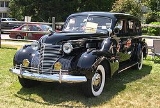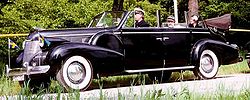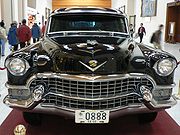
Cadillac Series 70
Encyclopedia
The Series 70 was one of Cadillac's full-size V8
-powered cars produced from the 1930s through 1970s. It replaced the 1935 355-D
as the company's mainstream car just as the much less expensive Series 60
was introduced. The Series 67 was similar to the Series 75 but produced on a longer wheelbase (139") for 1941 and 1942 only. The Series 80 (models 80 and 85) were the same as the Series 70 but used Cadillac's V12 engine
rather than the new V8
.
The short wheelbase Series 80 was produced for one model year only (1936). The long wheelbase Series 85 lasted one more year.
The short wheelbase Series 70 was replaced by the Series 60
in 1938, while the long wheelbase Series 75 would make a final appearance in the 1987 model year.
, though the bigger cars got the larger 346 in³ (5.7 L) engine. This 135 hp (101 kW) engine was both less expensive and more powerful, and the stylish body by Fleetwood
should have made the Series 70 an instant hit. However, the high price ($2,500 and up) limited its appeal in the depression era. 5,248 were sold for 1936.
The 1936 Series 70 was available in three basic models:
All three models shared the same engine and 3-speed transmission. Minor body style changes were made for 1937.
. It was produced for 1936 and 1937 only. Output was 150 hp (112 kW).
-bodied Series 75 used a 141 in (3,581.4 mm) wheelbase. It was available as a sedan, "Imperial", or "Formal Sedan". All Cadillacs shared the same 346 in³ L-head
V8
that year, though the 75 generated 140 hp (104 kW) instead of 135 hp (101 kW) like the rest of the line.


The Series 75 returned after the war as Cadillac's largest model. It retained most of its pre-war styling and rode on the long 136 in (3,454.4 mm) wheelbase. The engine was the same 346 in³ L-head
V8
used by other Cadillacs that year. A late model Series 75 is directly referenced, also having the model name Series 75 in 2K Games Mafia II under the game's Cadillac pseudonym, 'Lassiter'.
The new Cadillac OHV
V8
was the big news for 1949, with minor trim differences otherwise. This 331 in³ engine produced 160 hp (119 kW).
show car.
 Wheelbase was up to 149.8 in (3,805 mm) for 1954, and engine output jumped to 230 hp (172 kW). It was at 250 hp (186 kW) one year later. An optional dual-four barrel carb setup boasted 270 hp (201 kW).
Wheelbase was up to 149.8 in (3,805 mm) for 1954, and engine output jumped to 230 hp (172 kW). It was at 250 hp (186 kW) one year later. An optional dual-four barrel carb setup boasted 270 hp (201 kW).
The engine was stroked to 365 in³ for 285 or 305 hp (213 or 227 kW) in 1956.
The highly expensive and exclusive 4-door Cadillac Eldorado
Brougham hardtop marked the return of the Series 70, but for only two years, as from 1959-60 the Eldorado Brougham was denoted a Series 6900, and it was discontinued thereafter.
The engine was bumped to 429 in³ for 1964. 340 hp (254 kW) was the result.
The Series 75 changed over to the next generation of GM C-Body in the 1966 model year. This was one year later than other Cadillacs.
The 425 cu in (7.0 L) engine, a reduced bore 472, was further debored for 1980-1981 to 368 cubic inches or 6.0 liters. For 1981, the 368 was provided with a modulated displacement system designed by Eaton Corporation, controlled by a digital computer, which locked off intake and exhaust valves to two or four of the eight cylinders, thus running effectively as a V6 or V4 under light load conditions where in third gear, and over 35 mph (15.6 m/s). This engine was called the "V8-6-4", and its electronics and sensors proved troublesome and, except for limousines, this engine was dropped after 1981. The engine's controls and sensors were a stretch for the computer power of the era.
Both the 425 and 368 are small-bore versions of the durable 472 (which was introduced in late 1967 for the '68 model year). The larger 500 had the 472's bore but a longer stroke. This engine family was the last Cadillac cast-iron engine, and the last 'big-block'.
V8 engine
A V8 engine is a V engine with eight cylinders mounted on the crankcase in two banks of four cylinders, in most cases set at a right angle to each other but sometimes at a narrower angle, with all eight pistons driving a common crankshaft....
-powered cars produced from the 1930s through 1970s. It replaced the 1935 355-D
Cadillac Series 355
The Cadillac Series 355 was manufactured by the Cadillac Division of General Motors from 1931-1935. They were 8-cylinder cars, sold in several models: a 2-door club coupe, a 2-door convertible, 4-door convertible, a 4-door sedan and a 4-door town car. A radio was optional. In 1934, independent...
as the company's mainstream car just as the much less expensive Series 60
Cadillac Series 60
The Cadillac Series 60 was the company's mid-priced vehicle line when it appeared in 1936. It was replaced by the Series 61 in 1939, but the offshoot Sixty Special continued on and off through 1993....
was introduced. The Series 67 was similar to the Series 75 but produced on a longer wheelbase (139") for 1941 and 1942 only. The Series 80 (models 80 and 85) were the same as the Series 70 but used Cadillac's V12 engine
V12 engine
A V12 engine is a V engine with 12 cylinders mounted on the crankcase in two banks of six cylinders, usually but not always at a 60° angle to each other, with all 12 pistons driving a common crankshaft....
rather than the new V8
V8 engine
A V8 engine is a V engine with eight cylinders mounted on the crankcase in two banks of four cylinders, in most cases set at a right angle to each other but sometimes at a narrower angle, with all eight pistons driving a common crankshaft....
.
The short wheelbase Series 80 was produced for one model year only (1936). The long wheelbase Series 85 lasted one more year.
The short wheelbase Series 70 was replaced by the Series 60
Cadillac Series 60
The Cadillac Series 60 was the company's mid-priced vehicle line when it appeared in 1936. It was replaced by the Series 61 in 1939, but the offshoot Sixty Special continued on and off through 1993....
in 1938, while the long wheelbase Series 75 would make a final appearance in the 1987 model year.
1936–1937
Like the smaller car, the Series 70 was powered by the new 322 in³ Monobloc V8V8 engine
A V8 engine is a V engine with eight cylinders mounted on the crankcase in two banks of four cylinders, in most cases set at a right angle to each other but sometimes at a narrower angle, with all eight pistons driving a common crankshaft....
, though the bigger cars got the larger 346 in³ (5.7 L) engine. This 135 hp (101 kW) engine was both less expensive and more powerful, and the stylish body by Fleetwood
Fleetwood Metal Body
Fleetwood Metal Body was an automobile coachbuilder. The name derives from Fleetwood, Pennsylvania, home of the company at the start, and lived on for decades in the form of the Cadillac Fleetwood and various Fleetwood trim lines on Cadillac cars....
should have made the Series 70 an instant hit. However, the high price ($2,500 and up) limited its appeal in the depression era. 5,248 were sold for 1936.
The 1936 Series 70 was available in three basic models:
- 36-70 — 131 in (3,327 mm) wheelbase and 206.25 in (5,239 mm) overall length
- 36-75 — 138 in (3,505 mm) wheelbase and 213.5 in (5,423 mm) overall length
- 36-75 Commercial — 156 in (3,962 mm) wheelbase and 213.5 in (5,423 mm) overall length
All three models shared the same engine and 3-speed transmission. Minor body style changes were made for 1937.
Series 80
The Series 80 (models 80 and 85) was simply a model 70 or 75 with Cadillac's 368 in³ V12 engineV12 engine
A V12 engine is a V engine with 12 cylinders mounted on the crankcase in two banks of six cylinders, usually but not always at a 60° angle to each other, with all 12 pistons driving a common crankshaft....
. It was produced for 1936 and 1937 only. Output was 150 hp (112 kW).
1938–1940
The 1938 FleetwoodFleetwood Metal Body
Fleetwood Metal Body was an automobile coachbuilder. The name derives from Fleetwood, Pennsylvania, home of the company at the start, and lived on for decades in the form of the Cadillac Fleetwood and various Fleetwood trim lines on Cadillac cars....
-bodied Series 75 used a 141 in (3,581.4 mm) wheelbase. It was available as a sedan, "Imperial", or "Formal Sedan". All Cadillacs shared the same 346 in³ L-head
Cadillac V8 engine
Cadillac was the first automobile maker to mass produce a V8 engine. The company has produced eight generations of V8s since 1914, and was the last General Motors division to retain its own V8 design.-L-Head:...
V8
V8 engine
A V8 engine is a V engine with eight cylinders mounted on the crankcase in two banks of four cylinders, in most cases set at a right angle to each other but sometimes at a narrower angle, with all eight pistons driving a common crankshaft....
that year, though the 75 generated 140 hp (104 kW) instead of 135 hp (101 kW) like the rest of the line.


Series 72
The Series 72 of 1940 was somewhat smaller than the 75. It was also a Fleetwood car, but rode on a 138 in (3,505.2 mm) wheelbase.1941–1949
For 1941, the wheelbase was reduced to 136 in (3,454 mm), though engine power was up to 150 hp (112 kW).The Series 75 returned after the war as Cadillac's largest model. It retained most of its pre-war styling and rode on the long 136 in (3,454.4 mm) wheelbase. The engine was the same 346 in³ L-head
Cadillac V8 engine
Cadillac was the first automobile maker to mass produce a V8 engine. The company has produced eight generations of V8s since 1914, and was the last General Motors division to retain its own V8 design.-L-Head:...
V8
V8 engine
A V8 engine is a V engine with eight cylinders mounted on the crankcase in two banks of four cylinders, in most cases set at a right angle to each other but sometimes at a narrower angle, with all eight pistons driving a common crankshaft....
used by other Cadillacs that year. A late model Series 75 is directly referenced, also having the model name Series 75 in 2K Games Mafia II under the game's Cadillac pseudonym, 'Lassiter'.
The new Cadillac OHV
Cadillac V8 engine
Cadillac was the first automobile maker to mass produce a V8 engine. The company has produced eight generations of V8s since 1914, and was the last General Motors division to retain its own V8 design.-L-Head:...
V8
V8 engine
A V8 engine is a V engine with eight cylinders mounted on the crankcase in two banks of four cylinders, in most cases set at a right angle to each other but sometimes at a narrower angle, with all eight pistons driving a common crankshaft....
was the big news for 1949, with minor trim differences otherwise. This 331 in³ engine produced 160 hp (119 kW).
Series 67
The Series 67 of 1941-42 was somewhat larger than the 75. It was a Fisher car, but rode on a 139 in (3,530.6 mm) wheelbase.1950–1953
An all-new Series 75 was introduced for 1950. This would replace the final pre-war design at Cadillac, with a new 146.75 in (3,727.5 mm) wheelbase. 7-passenger seating was again offered via jump seats. Engine output for the 331 was up to 190 hp (142 kW) for 1952. It would borrow the bumper bullets (or dagmars) as a styling cue from the 1951 Le SabreLe Sabre concept car
The General Motors Le Sabre was a 1951 concept car. Possibly the most important show car of the 1950s, it introduced aircraft-inspired design elements such as the wrap-around windshield and tail fins, which became common on automotive designs during the second half of the decade.-History:The Le...
show car.
1954–1956

The engine was stroked to 365 in³ for 285 or 305 hp (213 or 227 kW) in 1956.
1957–1958
Power was 300 to 325 hp (224 to 242 kW) for 1957. The car was rebodied with more chunky styling. The 75 name had all but disappeared from the big Cadillac, and the engine was an even 325 hp (242 kW) from the 390 in³ engine.The highly expensive and exclusive 4-door Cadillac Eldorado
Cadillac Eldorado
The 1953 Eldorado was a special-bodied, low-production convertible . It was the production version of the 1952 El Dorado "Golden Anniversary" concept car, and borrowed bumper bullets from the 1951 GM Le Sabre show car...
Brougham hardtop marked the return of the Series 70, but for only two years, as from 1959-60 the Eldorado Brougham was denoted a Series 6900, and it was discontinued thereafter.
1959-1960
The long Fleetwood became the Series 6700, in keeping with Cadillac's new scheme, in 1960.1961-1965
The styling was also toned down. The engine was entirely changed for 1963, though the displacement and output remained the same.The engine was bumped to 429 in³ for 1964. 340 hp (254 kW) was the result.
The Series 75 changed over to the next generation of GM C-Body in the 1966 model year. This was one year later than other Cadillacs.
1966–1970
1971–1976
Cadillac Fleetwood Limousine (1977–1984)
In 1977 General Motors significantly down-sized their full sized cars. The Cadillac Fleetwood Limousine rode on a 144.5" wheelbase and was powered by a 425 cubic inch (7.0L) V8. This engine was basically a de bored version of the 472/500 (7.9 L/8.2 L) V8 of previous years. Compared with the 1976 Cadillac Fleetwood 75 which it replaced, the Cadillac Fleetwood Limousine had a wheelbase 7.0" shorter and weighed about 900 lb (340 kg) less.The 425 cu in (7.0 L) engine, a reduced bore 472, was further debored for 1980-1981 to 368 cubic inches or 6.0 liters. For 1981, the 368 was provided with a modulated displacement system designed by Eaton Corporation, controlled by a digital computer, which locked off intake and exhaust valves to two or four of the eight cylinders, thus running effectively as a V6 or V4 under light load conditions where in third gear, and over 35 mph (15.6 m/s). This engine was called the "V8-6-4", and its electronics and sensors proved troublesome and, except for limousines, this engine was dropped after 1981. The engine's controls and sensors were a stretch for the computer power of the era.
Both the 425 and 368 are small-bore versions of the durable 472 (which was introduced in late 1967 for the '68 model year). The larger 500 had the 472's bore but a longer stroke. This engine family was the last Cadillac cast-iron engine, and the last 'big-block'.

